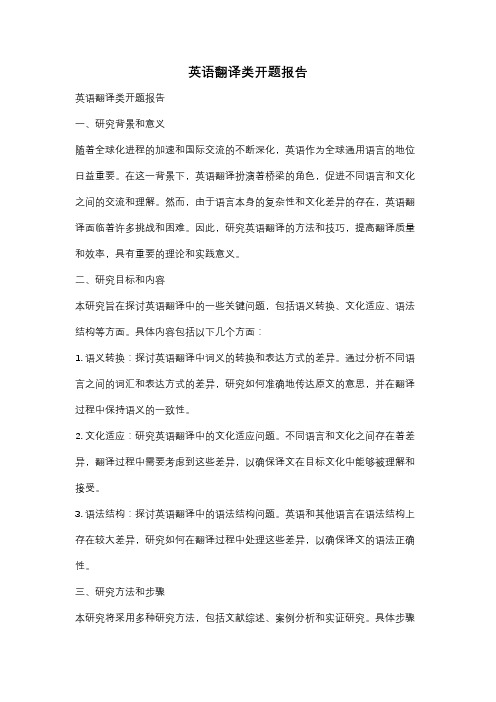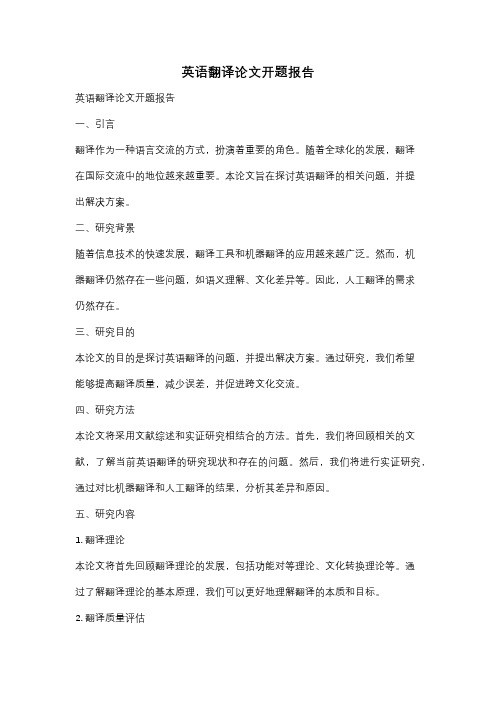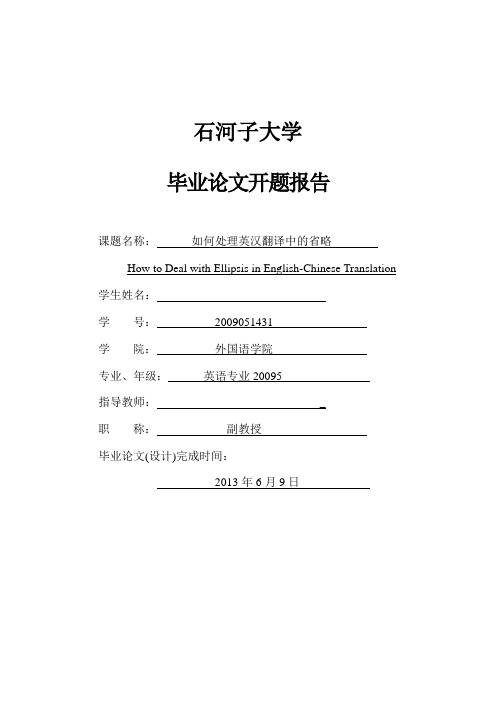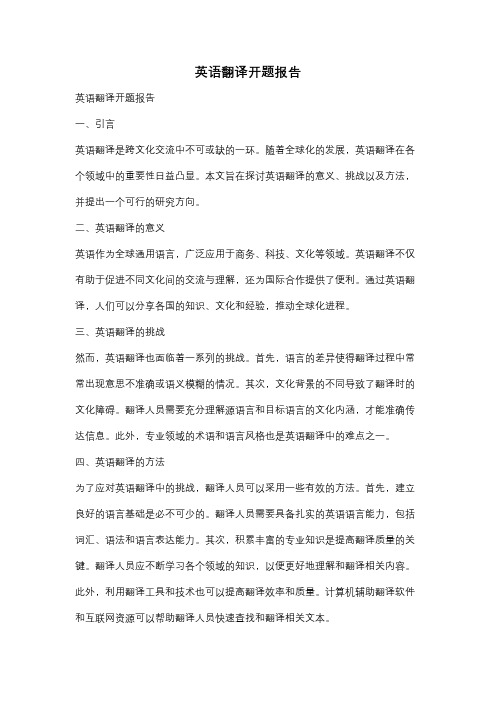英语专业翻译方向论文开题报告 3
英语专业开题报告(7篇)

英语专业开题报告(7篇)英语专业开题报告(7篇)在现在社会,我们使用报告的情况越来越多,多数报告都是在事情做完或发生后撰写的。
那么报告应该怎么写才合适呢?以下是小编为大家整理的英语专业开题报告,欢迎大家分享。
英语专业开题报告1开题报告是提高选题质量和水平的重要环节,是当学生确定毕业论文选瓜方向后,在调查研究墓础上撰写的报请学校批准的选题计划.它主要说明这个课压为何应该进行研究,自己拥有何种条件进行研究以及准备如何开展研究等问题,也可以说是对课题的论证和设计.指导教师应该认真引导学生写好开瓜报告,向学生阐述撰写开题报告的重要意义,并通过开月报告对学生的整个论文情况进行宏观的把握.那么如何指导英语专业学生写好开理报告,我将结合自己的教学实践谈谈自己的体会。
1、创新选题、合理定题进行开题报告写作的首要工作是指导学生进行选题,确切的说是进行论文方向的选择.这是正式书写开题报告前不可或缺的准备工作,是教师和学生都应该予以重视的重要环节.在这一过程中,学生会逐步对自己课月的研究方向渐渐清晰,脉络更加分明.确定论文写作方向一般有两种方式:"由面及点式"和"由点及面式".这是两种截然相反的选题思考过程.作为英语专业的学生,他们的选题方向主要有:语言学方向,翻译方向,文化方向,文学方向和教学法方向.学生可以根据自己的兴趣先选择一个大的方向,最终确立题目,这就是所谓的"由面及点式"的选题思路.例如,学生首先可以确定自己选越方向为文学,然后,在众多英美文学作品中选择自己比较熟悉和感兴趣的《简爱》,最后通过材料搜集、调查研究,找到自己的学术兴奋点,并最终确立题目《分析海伦的性格特征》。
比如说学生可以先选择《简爱》这部作品,然后确立写作方向.如果对作品语言分析,修辞特点分析,则可划分到语言学方向;如果是对其电影版本的台词翻译进行分析,那划分到了翻译方向:还可以通过这部作品分析中西方爱情观或中西方女性独立惫识,这就归为文化方向.这种"由点及面式"的选择思路往往比较适合平时学习注愈积累、善于思考的学生.这类学生在学习中往往普于发现间理和解决问瓜,具有一定的创新意识和问题意识.指导得当再加上学生自身的努力,往往会写出比较优秀的毕业论文。
英语翻译方向的开题报告

英语翻译方向的开题报告英语翻译方向的开题报告一、选题背景及意义英语翻译作为一门重要的语言学科,对于促进不同国家和文化之间的交流与合作起着至关重要的作用。
随着全球化进程的加快,英语翻译的需求也越来越大,因此深入研究英语翻译方向的问题具有重要的理论和实践意义。
二、研究目的和研究问题本研究旨在探讨英语翻译方向的相关问题,包括翻译理论、翻译方法和翻译实践等方面。
具体研究问题如下:1. 英语翻译的理论基础是什么?2. 英语翻译的方法有哪些?各自的特点和适用场景是什么?3. 英语翻译实践中存在的问题有哪些?如何解决这些问题?通过对这些问题的研究,可以为英语翻译的发展提供理论指导和实践经验。
三、研究方法和步骤本研究将采用文献综述和实证研究相结合的方法,具体步骤如下:1. 收集相关文献,包括翻译理论、翻译方法和翻译实践方面的经典著作和最新研究成果。
2. 对文献进行综述和分析,总结英语翻译的理论基础和方法特点。
3. 结合实际案例,对英语翻译实践中存在的问题进行调研和分析。
4. 提出解决问题的建议和措施,为英语翻译实践提供参考和借鉴。
通过以上步骤,可以全面了解英语翻译方向的现状和问题,并提出有针对性的解决方案。
四、预期研究结果和创新点本研究预期将得出以下结果:1. 对英语翻译的理论基础进行梳理和总结,明确其核心概念和基本原则。
2. 对英语翻译的方法进行分类和评价,分析各自的特点和适用场景。
3. 对英语翻译实践中存在的问题进行深入分析,提出解决问题的建议和措施。
本研究的创新点在于对英语翻译方向的综合研究,将理论和实践相结合,旨在为英语翻译的发展提供理论指导和实践经验。
五、研究的局限性和可行性分析本研究的局限性主要体现在以下几个方面:1. 数据的获取和分析可能存在一定的困难,需要耗费一定的时间和精力。
2. 由于研究时间和资源的限制,无法对所有英语翻译方向的问题进行全面研究,可能只能选择一些典型问题进行深入分析。
然而,本研究的可行性较高,主要原因如下:1. 文献综述是一种常见的研究方法,相关文献资源丰富,易于获取和分析。
英语翻译专业开题报告

英语翻译专业开题报告英语翻译专业开题报告一、选题背景随着全球化的加速发展,跨国交流与合作日益频繁,英语作为一种全球通用语言的地位变得愈发重要。
在这样的背景下,英语翻译专业的需求也越来越大。
本文将探讨英语翻译专业的开题报告,以期能够更好地了解该专业的发展趋势和应对方法。
二、研究目的本研究的目的在于探究英语翻译专业的发展现状、面临的挑战以及未来的发展方向。
通过对该专业的深入研究,可以为相关学生和从业者提供有针对性的建议和指导,促进英语翻译专业的健康发展。
三、研究方法本研究将采用文献综述和问卷调查相结合的方法进行。
首先,通过查阅相关文献资料,了解英语翻译专业的发展历程、现状和问题。
其次,设计并发放问卷调查,以收集学生和从业者的意见和建议。
最后,通过对文献和问卷数据的分析,得出结论并提出相应的建议。
四、研究内容1. 英语翻译专业的发展历程英语翻译专业的发展可以追溯到上个世纪初,当时随着国际交流的增加,人们对翻译人才的需求也逐渐增加。
然而,由于当时对翻译专业的认识不够深入和系统,培养出来的翻译人才往往不能满足实际需求。
随着时间的推移,翻译教育逐渐规范化,并逐步与语言学、文学等学科相结合,形成了独立的英语翻译专业。
2. 英语翻译专业的现状与问题目前,英语翻译专业在我国的高等教育体系中已经得到了广泛的认可和重视。
然而,与此同时,也存在一些问题。
首先,由于英语翻译专业的特殊性,培养出来的学生往往在实践能力方面存在一定的不足。
其次,随着机器翻译技术的不断发展,传统的人工翻译面临着一定的挑战。
此外,英语翻译专业的教学内容和方法也需要不断更新和改进。
3. 英语翻译专业的未来发展方向为了适应时代的发展和需求的变化,英语翻译专业需要不断调整和改进。
首先,应该注重培养学生的实践能力,提高其翻译实际操作的技能。
其次,应该加强对新兴技术的学习和应用,如机器翻译、云翻译等。
此外,还应加强与行业的合作,提供实习机会和就业指导,以提高学生的就业竞争力。
英语翻译类开题报告

英语翻译类开题报告英语翻译类开题报告一、研究背景和意义随着全球化进程的加速和国际交流的不断深化,英语作为全球通用语言的地位日益重要。
在这一背景下,英语翻译扮演着桥梁的角色,促进不同语言和文化之间的交流和理解。
然而,由于语言本身的复杂性和文化差异的存在,英语翻译面临着许多挑战和困难。
因此,研究英语翻译的方法和技巧,提高翻译质量和效率,具有重要的理论和实践意义。
二、研究目标和内容本研究旨在探讨英语翻译中的一些关键问题,包括语义转换、文化适应、语法结构等方面。
具体内容包括以下几个方面:1. 语义转换:探讨英语翻译中词义的转换和表达方式的差异。
通过分析不同语言之间的词汇和表达方式的差异,研究如何准确地传达原文的意思,并在翻译过程中保持语义的一致性。
2. 文化适应:研究英语翻译中的文化适应问题。
不同语言和文化之间存在着差异,翻译过程中需要考虑到这些差异,以确保译文在目标文化中能够被理解和接受。
3. 语法结构:探讨英语翻译中的语法结构问题。
英语和其他语言在语法结构上存在较大差异,研究如何在翻译过程中处理这些差异,以确保译文的语法正确性。
三、研究方法和步骤本研究将采用多种研究方法,包括文献综述、案例分析和实证研究。
具体步骤如下:1. 文献综述:对相关领域的文献进行综述,了解当前研究的进展和研究方法,为本研究提供理论基础和参考。
2. 案例分析:选择一些具有代表性的文本进行案例分析,分析其中的语义转换、文化适应和语法结构等问题。
通过对这些案例的分析,总结出一些通用的翻译方法和技巧。
3. 实证研究:通过实际的翻译实验,验证所提出的方法和技巧的有效性和可行性。
选择一些翻译难度较高的文本,进行翻译和评估,以验证所提出的方法和技巧的实际效果。
四、预期成果和应用价值本研究的预期成果包括以下几个方面:1. 理论贡献:通过对英语翻译中的关键问题进行深入研究,提出一些新的理论观点和方法,丰富和完善英语翻译的理论体系。
2. 实践指导:通过实证研究和案例分析,总结出一些通用的翻译方法和技巧,为英语翻译实践提供指导和参考。
英语翻译论文开题报告

英语翻译论文开题报告英语翻译论文开题报告一、引言翻译作为一种语言交流的方式,扮演着重要的角色。
随着全球化的发展,翻译在国际交流中的地位越来越重要。
本论文旨在探讨英语翻译的相关问题,并提出解决方案。
二、研究背景随着信息技术的快速发展,翻译工具和机器翻译的应用越来越广泛。
然而,机器翻译仍然存在一些问题,如语义理解、文化差异等。
因此,人工翻译的需求仍然存在。
三、研究目的本论文的目的是探讨英语翻译的问题,并提出解决方案。
通过研究,我们希望能够提高翻译质量,减少误差,并促进跨文化交流。
四、研究方法本论文将采用文献综述和实证研究相结合的方法。
首先,我们将回顾相关的文献,了解当前英语翻译的研究现状和存在的问题。
然后,我们将进行实证研究,通过对比机器翻译和人工翻译的结果,分析其差异和原因。
五、研究内容1. 翻译理论本论文将首先回顾翻译理论的发展,包括功能对等理论、文化转换理论等。
通过了解翻译理论的基本原理,我们可以更好地理解翻译的本质和目标。
2. 翻译质量评估翻译质量是翻译工作的核心问题。
本论文将探讨翻译质量评估的方法和标准,如BLEU、TER等。
通过评估翻译质量,我们可以了解翻译的准确性和流畅性,并找出改进的方向。
3. 机器翻译的问题与挑战尽管机器翻译在某些方面取得了很大的进展,但仍然存在一些问题和挑战。
本论文将分析机器翻译的问题,如语义理解、文化差异等,并提出解决方案。
4. 人工翻译的优势与局限与机器翻译相比,人工翻译具有一定的优势,如更好的语义理解和文化适应性。
然而,人工翻译也存在一些局限性。
本论文将探讨人工翻译的优势与局限,并提出改进的方法。
六、预期结果通过对英语翻译的研究,我们预期可以提出一些改进机器翻译和人工翻译的方法,以提高翻译质量。
我们还希望能够促进跨文化交流,减少误解和误译。
七、论文结构本论文将分为以下几个部分:1. 引言:介绍研究背景、目的和方法。
2. 翻译理论:回顾翻译理论的发展和基本原理。
英语专业翻译方向论文开题报告 3

石河子大学毕业论文开题报告课题名称:如何处理英汉翻译中的省略How to Deal with Ellipsis in English-Chinese Translation 学生姓名:学号:2009051431学院:外国语学院专业、年级:英语专业20095指导教师:_职称:副教授毕业论文(设计)完成时间:2013年6月9日How to Deal with Ellipsis in English-Chinese Translation I. Purpose and SignificanceWith the development of globalization, the world’s political, economic and cultural communications are becoming increasingly frequent. Therefore, the role of translation cannot be ignored. However, the differences between English and Chinese cultures that are reflected in the two languages pose considerable difficulty.It is acknowledged that when doing translation one can not translate word for word, or sentence by sentence. Therefore, we must use some translation strategies such as amplification, ellipsis, conversion and so on. Ellipsis as one of the basic translation methods plays an essential role in English-Chinese rendition. Translators apply it in order to make their versions more coherent and understandable.According to the Oxford Advanced Learner’s English-Chinese Dictionary, ellipsis means leaving out a word or words from a sentence deliberately, when the meaning can be understood without them. Ellipsis in translation does not mean cutting some content from the original articles. What could be omitted are words that are useless in translated works or else they will make the versions redundant or disobey the manner of expression in another language.Some words and phrases are useless in Chinese but necessary in English. Articles in English are the most significant phenomenon from this aspect. They are very important in English, but we can hardly see any reflection of this part in Chinese. Ellipsis is designed on the basis of faithfulness to the original text, making it more fluent, smooth, concise, thus conforming to idiomatic Chinese. The paper will explore ellipsis in English-Chinese translation from five aspects, which are ellipses of pronouns, conjunctions, articles, prepositions, modifications, so as to achieve smoother and clearer communications among China and English-speaking countries.II. Literature ReviewLong before, some people began to learn other countries’languages tounderstand others cultures. In China, Xuanzang was the first translator who not only translated the Sanskrit sutras into Chinese, but introduced the first Chinese writings to foreign countries, making foreigners understand China’s ancient culture. Meanwhile, he was the first to translate Lao Tse's works into Sanskrit. Indian scholars had a high opinion of Xuanzang, "In China, there is no such great translator, and also in the human cultural history, we can only say that Xuanzang is the first great translator."(Ye Lang, 2008) We can say that it was Xuanzang who motivated people to know the different parts of the world, their cultures and the peoples who live there. Then, some big countries such as America, China, and so on became a melting pot.(Gu Zhengkun, 2000) People have imperceptibly spent thousands of years in knowing each other.With China’s entry into WTO and its open-up policy, cross-cultural exchanges are increasingly frequent between this country and others. A lot of foreign tourists come to visit China. While traveling, these foreigners are not satisfied with the translations of the scenic spots. Sometimes, they even feel confused. A lot of problems exist in the translation, such as misuse of words, poor expression of meaning and so on. All of these poor translations do harm to our country’s international image, and cause a lot of inconveniences for the foreign visitors. (Ma Zuyi, 2000). I am fond of tourism and being a free tourist like the others who are good at enjoying their wonderful lives. The love of tourism makes me feel the need to improve the translation. But every time when I have a trip, many unsuitable translations of the names of those scenic spots will embarrass me. Tourism is part of intercultural communication, so proper translation of the scenic spots become more and more important to our country.Communication plays a significant role in the globalized society. In order to know each other better, people from all over the world have tried a verity of ways. Of course, translation is one of them. All translators have done their best to make the translated works more consistent with the needs of people.(Gu Jinming, 1997)From my perspective, they really have done a great job. And I want to retrospect the cause of their development. After a thorough evaluation, I choose a branch of translation—ellipsis in translation from English to Chinese, then I did the following jobs.I put all my researches and other stuffs together, and then I found that it is a common case in English and Chinese which draws much academic interest. In 1976, Halliday and Hsan classified ellipsis into nominal, verbal and clausal ellipsis. This classification exerts great influence in academic circle. Thereafter, ellipsis in Chineseand English has been studied according to this theory, which is based on different layers of structure. This kind of study underlines differentiations and similarities of ellipsis in Chinese and English.Another famous theory to explain ellipsis is Economy Principle. Economy Principle was put forward by Chomsky (1991,1993, and 1995) in his Generate Crammer. It maintains that language and linguistic study follow Economy Principle, which means using the least effort to express the most information. This principle just coincides with ellipsis in function.In this thesis, I think that brevity is the most obvious and common function of ellipsis, especially in daily language. And in both English and Chinese, people advocate brevity. Shakespeare once remarked, “brevity is the soul of wit”, and in Chinese there are numerous idioms like “yan jian yi gai”(meaning compendious). However, apart from the function of brevity, ellipsis embodies other functions which are also pretty common in the two languages but less noticed.(Hua Xianfa,2002)These functions distribute in both English and Chinese unevenly and represent great colorfulness of language. Exploring other functions of ellipsis and searching for functional recreation in translation will be of much benefit to both English to Chinese and Chinese to English translation.I found that when Chinese authors try to analyse ellipsis in English to Chinese translation, they always initially put articles in the list. They consider that it is a common phenomenon that Chinese always leave out personal articles. While it is obviously different in English that almost every sentence has a subject, we can see articles fluently. That is because when we translate from English to Chinese, personal articles can be omitted, even though sometimes it may appear once, it can also be omitted if necessary. Furthermore, if the objects can be seen obviously, personal articles should also be omitted. However, it never happens in English. From this point, it is not only allowable but also necessary when we translate personal articles which are objects in sentences into Chinese.In my point of view, the development of society has in some way has deliberately promoted the way of people’s thinking, translation system has become more and more perfect, people from all over the world have enjoyed the convenience. However, we can not neglect that there are still some problems in this field in China, and we have less influential Chinese translators in the world. Therefore, we still have a long way to go in translation.III. Feasibility AnalysisThis academic paper is a feasible project and the reasons are as follows:1.I have great interests in the way of English-Chinese translation.2.I have already studied translation methods and have been familiar with the functions and applications of ellipsis .3.I have collected enough references both Chinese and Western on ellipsis in translation and do a scrupulous study of the relationship between them.4.I have a carefully planned schedule and have worked out a detailed outline of this thesis.5.I have acquainted myself with the correct format, a clear and complete structure required by the academic paper, and my adequate Englishcompetence will enable me to write in fluent and precise English.6.My instructor is a qualified translator who is familiar with the subject I have chosen.IV. Problems of the research and solutions1. ProblemsDespite the references I have collected and read, a thorough study of ellipsis in English-Chinese translation from the point of freely using still needs far more. What’s more, owing to the limited ways of getting references in Xinjiang, I will have to make full use of my present resources. Also, this is the first time I have ever written such a serious academic paper. I am therefore a learner and lack the needed training and experience.2.Solutions(1) I shall make full use of my already acquired references which come from books, magazines and the Internet as well.(2) I shall value my own original thoughts and mainly rely on detailed analysis thatI have read from the books which have closely idea with my purpose.(3) When I have difficulties in the writing process, I shall consult my instructor and seek for help.V. Necessary conditions1. Our university and school of foreign languages have provided the basic study and research conditions and facilities, including books and journals in the library and reading rooms.2. The Internet is another source of information and on the campus we have easy access to the Internet.3. I have been assigned an instructor to guide me through the whole process of planning and writing.VI. OutlineI. IntroductionA. A Brief Introduction of Ellipsis in TranslationB. What Should We Pay Attention to When Dealing with EllipsisC. The Reason Why Ellipsis Is So Widely Used in Translation1. Chinese Expressions Are Much Briefer Than That of English2. English Grammar Is Wee-Knit and Complete in Sentence StructureII. The Principles of EllipsisA. Omitted Words Must Be Useless And Unnecessary in the Translated WorksB. The Meaning of the Omitted Words Is Implied in the TestC. Omitted Words Which Are Self-EvidentШ. The Functions and Applications of EllipsisA. The Coherence of the Meaning of ExpressionB. The Coincidence of the Manner of Expression1. Ellipsis of Articlesa. Ellipsis of Definite Articlesb. Ellipsis of Indefinite Articles2. Ellipsis of Prepositions3. Ellipsis of Pronounsa. Ellipsis of Personal and Impersonal Pronounsb. Ellipsis of Indefinite Pronounsc. Ellipsis of Relative Pronouns4. Ellipsis of Conjunctionsa. Ellipsis of Coordinating Conjunctionsb. Ellipsis of Subordinate Conjunctions5. Ellipsis of Rhetorica. Ellipsis of Repeated Wordsb. Ellipsis of SynonymsIV. ConclusionVII. ScheduleTime ProgramDec.1,2012-Dec.28, 2012 (4weeks)Thesis proposal (literature review) Dec.29, 2011-Mar.3,2013 (9weeks)The first draftMar.4,2013-Apr.7, 2013 (5weeks)The second draftApr.8,2013-Apr.21,2013 (2 week)The third draftMay, 6, 2013 The final draft paperJune, 9, 2013 Oral defenseWorks CitedBassnett M. S. Translation Studies. London: Methuen&Co.Ltd. , 1990 Seleskovitch, Danica. Interpreting for International Conferences [M]. Tran. Stephanie Dailey and Eric Norman McMillan. 3rd edition. Washington D.C.: Pen andBooth, 2002古今明. 英汉基础翻译[M]. 上海:上海外语教育出版社,1997辜正坤. 翻译标准多元互补论. 北京:中国对外研究出版公司,2000华先发. 新实用英译汉教程[M]. 武汉:湖北教育出版社,2002吕俊,侯向群. 英汉翻译教程[M]. 上海:上海外语教育出版社,2002马祖毅. 中国翻译简史[M]. 北京:中国对外翻译出版社,2000任文. 交替传译. 北京:外语教学与研究出版社,2004叶朗,朱良志. Insight into Chinese Culture. 北京:外语教学与研究出版社,2008 张培基. 英译中国现代散文选[M]. 上海外语教育出版社,2002说明:一、学生撰写《开题报告》应包含的内容:1、本课题来源及研究的目的和意义。
翻译方向论文开题报告

翻译方向论文开题报告翻译方向论文开题报告一、研究背景和意义翻译作为一种跨文化交际工具,在国际交流中起着重要的作用。
随着全球化的发展和国际交往的频繁,翻译的需求不断增加。
然而,翻译并非简单的语言转换,而是一种复杂的文化传递过程。
因此,研究翻译方向对于提高翻译质量、促进跨文化交流具有重要意义。
二、研究目的和研究问题本研究旨在探讨翻译方向的相关问题,以提高翻译质量和效率。
具体研究问题包括但不限于:1. 翻译方向对翻译质量的影响;2. 翻译方向的选择与翻译效率的关系;3. 不同语言间翻译方向的异同。
通过对这些问题的研究,可以为翻译实践提供理论指导,提高翻译质量和效率。
三、研究方法本研究将采用多种研究方法,包括文献综述、实证研究和对比分析等。
首先,通过文献综述,了解翻译方向的相关理论和研究现状。
然后,进行实证研究,通过实际翻译案例,分析翻译方向对翻译质量的影响,并探讨翻译方向的选择与翻译效率的关系。
最后,进行对比分析,比较不同语言间翻译方向的异同,寻找共性和差异。
四、预期结果本研究预期将得出以下结果:1. 翻译方向对翻译质量有一定影响,不同方向可能存在优劣之分;2. 翻译方向的选择与翻译效率有一定关系,不同方向可能影响翻译速度和准确度;3. 不同语言间翻译方向存在一定的异同,可能受到语言结构和文化差异的影响。
五、研究意义和应用前景本研究的意义在于提高翻译质量和效率,促进跨文化交流。
通过深入研究翻译方向的相关问题,可以为翻译实践提供理论指导,帮助翻译人员更好地选择翻译方向,提高翻译质量。
同时,研究结果还可为翻译工具和机器翻译的开发提供参考,提高翻译效率。
六、研究计划本研究计划分为以下几个阶段:1. 阶段一:文献综述。
对翻译方向的相关理论和研究现状进行综述,明确研究问题和研究目标。
2. 阶段二:实证研究。
通过实际翻译案例,分析翻译方向对翻译质量的影响,并探讨翻译方向的选择与翻译效率的关系。
3. 阶段三:对比分析。
英语翻译开题报告

英语翻译开题报告英语翻译开题报告一、引言英语翻译是跨文化交流中不可或缺的一环。
随着全球化的发展,英语翻译在各个领域中的重要性日益凸显。
本文旨在探讨英语翻译的意义、挑战以及方法,并提出一个可行的研究方向。
二、英语翻译的意义英语作为全球通用语言,广泛应用于商务、科技、文化等领域。
英语翻译不仅有助于促进不同文化间的交流与理解,还为国际合作提供了便利。
通过英语翻译,人们可以分享各国的知识、文化和经验,推动全球化进程。
三、英语翻译的挑战然而,英语翻译也面临着一系列的挑战。
首先,语言的差异使得翻译过程中常常出现意思不准确或语义模糊的情况。
其次,文化背景的不同导致了翻译时的文化障碍。
翻译人员需要充分理解源语言和目标语言的文化内涵,才能准确传达信息。
此外,专业领域的术语和语言风格也是英语翻译中的难点之一。
四、英语翻译的方法为了应对英语翻译中的挑战,翻译人员可以采用一些有效的方法。
首先,建立良好的语言基础是必不可少的。
翻译人员需要具备扎实的英语语言能力,包括词汇、语法和语言表达能力。
其次,积累丰富的专业知识是提高翻译质量的关键。
翻译人员应不断学习各个领域的知识,以便更好地理解和翻译相关内容。
此外,利用翻译工具和技术也可以提高翻译效率和质量。
计算机辅助翻译软件和互联网资源可以帮助翻译人员快速查找和翻译相关文本。
五、研究方向基于以上的讨论,本文提出了一个可行的研究方向,即英语翻译中的文化因素对翻译质量的影响。
文化因素在英语翻译中起着重要的作用,但目前相关研究还相对较少。
本研究将通过对比不同文化背景下的翻译实例,分析文化因素对翻译质量的影响,并探讨如何在翻译过程中更好地处理文化差异。
六、研究方法本研究将采用案例研究的方法,选择不同领域的英语翻译实例进行分析。
通过对比源语言和目标语言的文化内涵,分析文化因素对翻译质量的影响。
同时,将结合问卷调查和访谈等方法,收集翻译人员和用户的反馈意见,以便更全面地了解文化因素对翻译的影响。
- 1、下载文档前请自行甄别文档内容的完整性,平台不提供额外的编辑、内容补充、找答案等附加服务。
- 2、"仅部分预览"的文档,不可在线预览部分如存在完整性等问题,可反馈申请退款(可完整预览的文档不适用该条件!)。
- 3、如文档侵犯您的权益,请联系客服反馈,我们会尽快为您处理(人工客服工作时间:9:00-18:30)。
石河子大学毕业论文开题报告课题名称:如何处理英汉翻译中的省略How to Deal with Ellipsis in English-Chinese Translation 学生姓名:学号:2009051431学院:外国语学院专业、年级:英语专业20095指导教师:_职称:副教授毕业论文(设计)完成时间:2013年6月9日How to Deal with Ellipsis in English-Chinese Translation I. Purpose and SignificanceWith the development of globalization, the world’s political, economic and cultural communications are becoming increasingly frequent. Therefore, the role of translation cannot be ignored. However, the differences between English and Chinese cultures that are reflected in the two languages pose considerable difficulty.It is acknowledged that when doing translation one can not translate word for word, or sentence by sentence. Therefore, we must use some translation strategies such as amplification, ellipsis, conversion and so on. Ellipsis as one of the basic translation methods plays an essential role in English-Chinese rendition. Translators apply it in order to make their versions more coherent and understandable.According to the Oxford Advanced Learner’s English-Chinese Dictionary, ellipsis means leaving out a word or words from a sentence deliberately, when the meaning can be understood without them. Ellipsis in translation does not mean cutting some content from the original articles. What could be omitted are words that are useless in translated works or else they will make the versions redundant or disobey the manner of expression in another language.Some words and phrases are useless in Chinese but necessary in English. Articles in English are the most significant phenomenon from this aspect. They are very important in English, but we can hardly see any reflection of this part in Chinese. Ellipsis is designed on the basis of faithfulness to the original text, making it more fluent, smooth, concise, thus conforming to idiomatic Chinese. The paper will explore ellipsis in English-Chinese translation from five aspects, which are ellipses of pronouns, conjunctions, articles, prepositions, modifications, so as to achieve smoother and clearer communications among China and English-speaking countries.II. Literature ReviewLong before, some people began to learn other countries’languages tounderstand others cultures. In China, Xuanzang was the first translator who not only translated the Sanskrit sutras into Chinese, but introduced the first Chinese writings to foreign countries, making foreigners understand China’s ancient culture. Meanwhile, he was the first to translate Lao Tse's works into Sanskrit. Indian scholars had a high opinion of Xuanzang, "In China, there is no such great translator, and also in the human cultural history, we can only say that Xuanzang is the first great translator."(Ye Lang, 2008) We can say that it was Xuanzang who motivated people to know the different parts of the world, their cultures and the peoples who live there. Then, some big countries such as America, China, and so on became a melting pot.(Gu Zhengkun, 2000) People have imperceptibly spent thousands of years in knowing each other.With China’s entry into WTO and its open-up policy, cross-cultural exchanges are increasingly frequent between this country and others. A lot of foreign tourists come to visit China. While traveling, these foreigners are not satisfied with the translations of the scenic spots. Sometimes, they even feel confused. A lot of problems exist in the translation, such as misuse of words, poor expression of meaning and so on. All of these poor translations do harm to our country’s international image, and cause a lot of inconveniences for the foreign visitors. (Ma Zuyi, 2000). I am fond of tourism and being a free tourist like the others who are good at enjoying their wonderful lives. The love of tourism makes me feel the need to improve the translation. But every time when I have a trip, many unsuitable translations of the names of those scenic spots will embarrass me. Tourism is part of intercultural communication, so proper translation of the scenic spots become more and more important to our country.Communication plays a significant role in the globalized society. In order to know each other better, people from all over the world have tried a verity of ways. Of course, translation is one of them. All translators have done their best to make the translated works more consistent with the needs of people.(Gu Jinming, 1997)From my perspective, they really have done a great job. And I want to retrospect the cause of their development. After a thorough evaluation, I choose a branch of translation—ellipsis in translation from English to Chinese, then I did the following jobs.I put all my researches and other stuffs together, and then I found that it is a common case in English and Chinese which draws much academic interest. In 1976, Halliday and Hsan classified ellipsis into nominal, verbal and clausal ellipsis. This classification exerts great influence in academic circle. Thereafter, ellipsis in Chineseand English has been studied according to this theory, which is based on different layers of structure. This kind of study underlines differentiations and similarities of ellipsis in Chinese and English.Another famous theory to explain ellipsis is Economy Principle. Economy Principle was put forward by Chomsky (1991,1993, and 1995) in his Generate Crammer. It maintains that language and linguistic study follow Economy Principle, which means using the least effort to express the most information. This principle just coincides with ellipsis in function.In this thesis, I think that brevity is the most obvious and common function of ellipsis, especially in daily language. And in both English and Chinese, people advocate brevity. Shakespeare once remarked, “brevity is the soul of wit”, and in Chinese there are numerous idioms like “yan jian yi gai”(meaning compendious). However, apart from the function of brevity, ellipsis embodies other functions which are also pretty common in the two languages but less noticed.(Hua Xianfa,2002)These functions distribute in both English and Chinese unevenly and represent great colorfulness of language. Exploring other functions of ellipsis and searching for functional recreation in translation will be of much benefit to both English to Chinese and Chinese to English translation.I found that when Chinese authors try to analyse ellipsis in English to Chinese translation, they always initially put articles in the list. They consider that it is a common phenomenon that Chinese always leave out personal articles. While it is obviously different in English that almost every sentence has a subject, we can see articles fluently. That is because when we translate from English to Chinese, personal articles can be omitted, even though sometimes it may appear once, it can also be omitted if necessary. Furthermore, if the objects can be seen obviously, personal articles should also be omitted. However, it never happens in English. From this point, it is not only allowable but also necessary when we translate personal articles which are objects in sentences into Chinese.In my point of view, the development of society has in some way has deliberately promoted the way of people’s thinking, translation system has become more and more perfect, people from all over the world have enjoyed the convenience. However, we can not neglect that there are still some problems in this field in China, and we have less influential Chinese translators in the world. Therefore, we still have a long way to go in translation.III. Feasibility AnalysisThis academic paper is a feasible project and the reasons are as follows:1.I have great interests in the way of English-Chinese translation.2.I have already studied translation methods and have been familiar with the functions and applications of ellipsis .3.I have collected enough references both Chinese and Western on ellipsis in translation and do a scrupulous study of the relationship between them.4.I have a carefully planned schedule and have worked out a detailed outline of this thesis.5.I have acquainted myself with the correct format, a clear and complete structure required by the academic paper, and my adequate Englishcompetence will enable me to write in fluent and precise English.6.My instructor is a qualified translator who is familiar with the subject I have chosen.IV. Problems of the research and solutions1. ProblemsDespite the references I have collected and read, a thorough study of ellipsis in English-Chinese translation from the point of freely using still needs far more. What’s more, owing to the limited ways of getting references in Xinjiang, I will have to make full use of my present resources. Also, this is the first time I have ever written such a serious academic paper. I am therefore a learner and lack the needed training and experience.2.Solutions(1) I shall make full use of my already acquired references which come from books, magazines and the Internet as well.(2) I shall value my own original thoughts and mainly rely on detailed analysis thatI have read from the books which have closely idea with my purpose.(3) When I have difficulties in the writing process, I shall consult my instructor and seek for help.V. Necessary conditions1. Our university and school of foreign languages have provided the basic study and research conditions and facilities, including books and journals in the library and reading rooms.2. The Internet is another source of information and on the campus we have easy access to the Internet.3. I have been assigned an instructor to guide me through the whole process of planning and writing.VI. OutlineI. IntroductionA. A Brief Introduction of Ellipsis in TranslationB. What Should We Pay Attention to When Dealing with EllipsisC. The Reason Why Ellipsis Is So Widely Used in Translation1. Chinese Expressions Are Much Briefer Than That of English2. English Grammar Is Wee-Knit and Complete in Sentence StructureII. The Principles of EllipsisA. Omitted Words Must Be Useless And Unnecessary in the Translated WorksB. The Meaning of the Omitted Words Is Implied in the TestC. Omitted Words Which Are Self-EvidentШ. The Functions and Applications of EllipsisA. The Coherence of the Meaning of ExpressionB. The Coincidence of the Manner of Expression1. Ellipsis of Articlesa. Ellipsis of Definite Articlesb. Ellipsis of Indefinite Articles2. Ellipsis of Prepositions3. Ellipsis of Pronounsa. Ellipsis of Personal and Impersonal Pronounsb. Ellipsis of Indefinite Pronounsc. Ellipsis of Relative Pronouns4. Ellipsis of Conjunctionsa. Ellipsis of Coordinating Conjunctionsb. Ellipsis of Subordinate Conjunctions5. Ellipsis of Rhetorica. Ellipsis of Repeated Wordsb. Ellipsis of SynonymsIV. ConclusionVII. ScheduleTime ProgramDec.1,2012-Dec.28, 2012 (4weeks)Thesis proposal (literature review) Dec.29, 2011-Mar.3,2013 (9weeks)The first draftMar.4,2013-Apr.7, 2013 (5weeks)The second draftApr.8,2013-Apr.21,2013 (2 week)The third draftMay, 6, 2013 The final draft paperJune, 9, 2013 Oral defenseWorks CitedBassnett M. S. Translation Studies. London: Methuen&Co.Ltd. , 1990 Seleskovitch, Danica. Interpreting for International Conferences [M]. Tran. Stephanie Dailey and Eric Norman McMillan. 3rd edition. Washington D.C.: Pen andBooth, 2002古今明. 英汉基础翻译[M]. 上海:上海外语教育出版社,1997辜正坤. 翻译标准多元互补论. 北京:中国对外研究出版公司,2000华先发. 新实用英译汉教程[M]. 武汉:湖北教育出版社,2002吕俊,侯向群. 英汉翻译教程[M]. 上海:上海外语教育出版社,2002马祖毅. 中国翻译简史[M]. 北京:中国对外翻译出版社,2000任文. 交替传译. 北京:外语教学与研究出版社,2004叶朗,朱良志. Insight into Chinese Culture. 北京:外语教学与研究出版社,2008 张培基. 英译中国现代散文选[M]. 上海外语教育出版社,2002说明:一、学生撰写《开题报告》应包含的内容:1、本课题来源及研究的目的和意义。
